#Cloud Infrastructure Security
Explore tagged Tumblr posts
Text
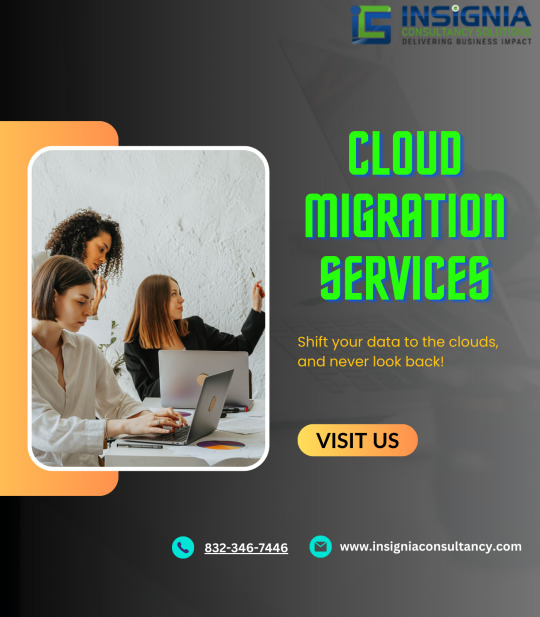
Fortify Your Cloud Infrastructure: Top Security Solutions
Discover how to fortify your cloud infrastructure against cyber threats and data breaches. Explore top security solutions and best practices for staying protected in the cloud.
#Cloud Infrastructure Security#best digital marketing company india#business consulting firm#snowflake developers#salesforce consultants#company for digital marketing#saphana#servicenow#digital transformation#website redesign
0 notes
Text
ZeaCloud® Public Cloud – Scalable & Secure IaaS Solutions
ZeaCloud® offers automated, pay‑as‑you‑go Infrastructure‑as‑a‑Service (IaaS) based in New Delhi. Enjoy scalable storage, networking, and compute powered by NVMe and virtualization, with 24×7 AI‑augmented support and simplified self‑service interfaces. Ideal for enterprises seeking reliable, cost‑effective cloud transformation. for more details visit: Zeacloud- Public Cloud Page
#Public Cloud#Infrastructure as a Service (IaaS)#Scalable Cloud Solutions#Pay‑as‑you‑go Cloud#NVMe Storage#Managed Cloud Services#Automated Cloud Infrastructure#24×7 Cloud Support#Virtualization#Self‑Service Cloud Dashboard#ZeaCloud#Cloud in New Delhi#Secure Cloud Hosting
0 notes
Text
#cloud services#devops solutions#cloud computing#infrastructure automation#CI/CD pipeline#cloud and devops services#cloud migration#enterprise devops#cloud security#cloud-native development#cloud deployment services#continuous delivery#cloud consulting services#managed cloud services#devops consulting company#hybrid cloud solutions#cloud optimization#instep technologies
0 notes
Text
The advantages of Computer Networks: Enhancing Connectivity & Efficiency
Computer networks form the backbone of modern communication, business operations, and data management, enabling seamless connectivity and resource sharing. Whether in workplaces, homes, or global enterprises, networking has transformed the way we exchange information. Here’s why computer networks are essential for efficiency, security, and collaboration. 1. Seamless Communication &…
#business connectivity#cloud storage solutions#computer networking benefits#digital collaboration#IT infrastructure efficiency#network performance optimization#secure data sharing
1 note
·
View note
Text

Migrate to Oracle Cloud with Zero Upfront Costs: A Cost-Effective Path to Modernization
The era of traditional IT resources has ended as they come with high maintenance costs, resource constraints, and limited agility. This is where Oracle Cloud transforms the game, offering enterprises cost-effective, risk-free roadmap with zero upfront investment.
Oracle Cloud Infrastructure (OCI) is known for its cutting-edge cloud computing capabilities where organizations can seamlessly migrate workloads, optimize performance, and reduce OPEX. It’s a complete infrastructure that’s powered by AI capabilities to help businesses build a future-ready ecosystem at lower costs.
How to Modernize with Oracle Cloud at Minimal Cost?
Leverage Oracle Cloud’s Free Tier: Oracle offers an extensive Cloud Migration program, including free-tier services and promotional credits. This allows businesses to test and deploy workloads in Oracle Cloud Infrastructure (OCI) without any initial financial commitment, making the transition smooth.
Pay-As-You-Go Flexibility for Cost Optimization: Traditional infrastructure demands heavy capital investment. In contrast, Oracle Cloud Computing operates on a pay-as-you-go model—eliminating upfront hardware and licensing costs while providing full scalability to adjust resources based on demand.
Lift-and-Shift with Zero Downtime: INFOLOB’s unique trifold migration methodology enables businesses to move applications and databases with zero downtime and minimal disruption. This ensures business operations continue uninterrupted while modernizing IT infrastructure.
Multi-Layered Security: Oracle’s Cloud Computing environment includes built-in security features such as encryption, identity management, and advanced threat detection—eliminating the need for costly third-party security solutions while ensuring compliance.
Hybrid and Multicloud Flexibility: For enterprises that require a hybrid cloud or multicloud strategy, OCI offers seamless integration with on-premises environments and third-party clouds. This flexibility ensures businesses can transition at their own pace without overspending on unnecessary infrastructure.
Expert-Led Oracle Cloud Migration Assistance: Our dedicated migration experts and partners provide comprehensive assistance, ensuring enterprises move to Oracle Cloud Infrastructure efficiently. This reduces migration complexities and helps businesses achieve faster time-to-value without additional overhead costs.
Migrate to Oracle Cloud and gain end-to-end business benefits, led by INFOLOB cloud experts.
Tags: Oracle Cloud, Oracle Cloud Migration, Oracle Cloud Infrastructure, OCI, Cloud Modernization, Zero Upfront Cost, Cloud Cost Optimization, Pay-as-you-go Cloud, Cloud Flexibility, Cloud Security, AI in Cloud, INFOLOB Cloud Services, Hybrid Cloud, Multicloud Strategy, Lift and Shift Migration, Zero Downtime Migration, Cloud Computing, Cloud Infrastructure as a Service, Cloud Platform as a Service, Cloud Software as a Service, OCI Free Tier, Enterprise Cloud Strategy, Cloud Migration Experts, Future Ready IT, Cloud Transformation, Digital Modernization, Cloud Scalability, Cloud Integration, Risk-Free Cloud Migration, Cloud ROI, Oracle Cloud AI, Trifold Migration Methodology.
For more Info:
Call: +1 (469) 393-0378
Mail: [email protected]
www.infolob.com
#Oracle Cloud#Oracle Cloud Migration#Oracle Cloud Infrastructure#OCI#Cloud Modernization#Zero Upfront Cost#Cloud Cost Optimization#Pay-as-you-go Cloud#Cloud Flexibility#Cloud Security#AI in Cloud#INFOLOB Cloud Services#Hybrid Cloud
1 note
·
View note
Text
Beyond the Buzz: How IoT Redefines Business Operations

Moving from Hype to Reality
IoT has moved from being a futuristic idea to a practical solution that businesses use daily to improve operations and achieve sustainable growth. Though much of the discussion around IoT is about its potential, the real value that it presents is in how companies can use the technology to solve real-world problems.
Today, IoT is no longer a buzzword; it’s a necessity for any business looking to remain competitive and agile in a dynamic global environment. With its power to integrate devices, data, and processes, IoT helps businesses achieve efficiencies, improve customer satisfaction, and create new revenue streams. In this blog post, we explore how IoT is changing business operations across industries and what companies need to do to maximize its potential.
How Tudip Technologies Redefines IoT Solutions
Tudip Technologies empowers businesses with IoT solutions that tackle complex operational challenges and drive measurable outcomes.
Our Specialized Approach:
Edge Computing Integration: Enabling faster data processing closer to devices for real-time responsiveness.
IoT Ecosystem Design: Creating scalable ecosystems that adapt to changing business needs.
Sustainability-Focused Solutions: Tailoring IoT frameworks that align with environmental goals.
Example: Tudip partnered with a logistics provider to implement IoT-powered edge analytics, reducing data processing times by 60% and improving delivery accuracy across global operations.
Key Takeaways: Turning IoT Into Operational Strength
Invest in Scalable Solutions: Ensure your IoT systems can grow alongside your business needs.
Prioritize Security: Robust cybersecurity measures arToday, IoT is no longer a buzzword; it’s a necessity for any business looking to remain competitive and agile in a dynamic global environment. With its power to integrate devices, data, and processes, IoT helps businesses achieve efficiencies, improve customer satisfaction, and create new revenue streams. In this blog post, we explore how IoT is changing business operations across industries and what companies need to do to maximize its potential.
Redefining Operational Efficiency with IoT
1. Predictive Analytics: Smarter Urban Operations with IoT
IoT is revolutionizing energy management by integrating renewable energy sources into business operations. Smart systems analyze usage patterns and adjust power drawn from solar, wind, or traditional grids in real time.
Optimized Renewable Usage: IoT ensures renewable energy is used efficiently by monitoring supply-demand gaps.
Grid Stability: Balances energy loads to prevent outages during peak hours.
Sustainability Goals: Helps businesses achieve net-zero emissions by prioritizing clean energy consumption.
Example: A technology campus integrated IoT in optimizing its solar energy consumption and reduced dependence on traditional grids by 40%, with a significant reduction in operational costs
2. Energy Management: Advancing Renewable Solutions
Predictive analytics powered by IoT is transforming urban infrastructure. Cities can now monitor critical assets like bridges, roads, and utilities in real time, ensuring timely maintenance and preventing costly failures.
Public Safety: Early detection of infrastructure stress minimizes risks to citizens.
Cost Efficiency: Avoiding large-scale repairs reduces budget overruns for municipalities.
Sustainability: Proactive maintenance extends the lifespan of assets, reducing waste.
3. Automation Excellence: Better Disaster Response Logistics
IoT-driven automation is transforming how disaster response occurs—getting aid to where it is needed, faster and more efficiently.
Real-Time Inventory Management: Monitors relief inventory and ensures its proper distribution to areas of greatest need.
Smart Transportation: Optimizes routes for rescue and supply vehicles during crises.
Collaboration Across Agencies: IoT systems enable seamless communication between response teams.
Example:In a recent hurricane, one global aid organization leveraged IoT-connected drones to survey damage and automate the delivery of supplies, resulting in a 50% faster response time.
Overcoming Common IoT Challenges
1. Integration of IoT with Existing Systems
One of the biggest hurdles businesses face is integrating IoT solutions with legacy systems. Compatibility issues can hinder seamless data exchange and functionality. Solution: Use a flexible IoT platform with built-in interoperability; make sure it provides APIs for smooth integration. Careful planning and phased implementation may also reduce disruptions to a minimum.
2. Data Security and Privacy
IoT ecosystems are all about continuous data gathering and transmission, which increases exposure to cyber threats. The security of sensitive information is the foundation of trust with stakeholders.
Solution: Implement robust encryption protocols, regularly update security measures, and educate employees on cybersecurity best practices.
3. Adapting to Rapid Technological Changes
The rapid rate of innovation in IoT can make it challenging for businesses to adapt to new developments and keep their systems current. Solution: Collaborate with technology providers that offer scalable solutions and ongoing support to adapt to emerging trends without overhauling existing systems.
How IoT Drives Operational Transformation
1. Enhancing Decision-Making with Real-Time Insights
IoT provides companies with real-time data that enables informed decision-making. Whether it is revising supply chain strategies or optimizing production schedules, IoT ensures that companies can act quickly and confidently.
Dynamic Adaptability: Businesses can change their strategies according to up-to-date information and stay responsive to market demand.
Improved Collaboration: IoT systems enable better communication across departments, enabling coordinated efforts.
2. Creating Value Through Customization
IoT’s ability to collect granular data allows businesses to tailor their offerings and services to meet specific customer needs. Personalization not only enhances user experience but also builds stronger customer relationships.
e non-negotiable in today’s interconnected world.
Focus on Outcomes: Use IoT to achieve specific goals, whether it’s reducing costs, enhancing customer satisfaction, or achieving sustainability targets.
Conclusion: Moving Beyond the Buzz
IoT has evolved into an indispensable solution, reshaping how businesses optimize operations and achieve sustainable growth. By addressing real-world challenges and delivering actionable insights, IoT enables companies to stay competitive and adaptive.
To fully realize the benefits of IoT, businesses must focus on integrating flexible solutions, safeguarding data, and aligning technology with strategic objectives. With the right approach, IoT becomes more than a technological innovation—it becomes a cornerstone of operational excellence and sustainable growth.
Click the link below to learn more about the blog Beyond the Buzz: How IoT Redefines Business Operations
https://tudip.com/blog-post/beyond-the-buzz-how-iot-redefines-business-operations/
#Tudip#IoT#Internet of Things#business operations#predictive analytics#automation#real-time data#edge computing#smart infrastructure#energy management#renewable energy#sustainability#operational efficiency#cybersecurity#data security#interoperability#digital transformation#scalability#AI-driven insights#machine learning#supply chain optimization#disaster response#smart cities#industrial IoT#connected devices#enterprise IoT#cloud computing#IoT platforms#remote monitoring#predictive maintenance
0 notes
Text
How to Secure Your Cloud Infrastructure on a Budget
Introduction Let’s face it—cloud security can feel like a luxury reserved for tech giants with deep pockets. But here’s the good news: you don’t need a massive budget to keep your cloud infrastructure safe. Whether you’re a small business, startup, or solo developer, securing your cloud setup is absolutely doable—without breaking the bank. In fact, some of the best practices don’t cost a dime. So…
#best free cloud protection#cloud security for small business#cloud security on a budget#low-cost cloud security tools#secure cloud infrastructure
0 notes
Text
Comprehensive IT Infrastructure Solutions | Vivency Technology LLC
Vivency Technology LLC offers expert IT infrastructure solutions to help businesses build, manage, and optimize their IT environments. Our services include network solutions, data center solutions, cybersecurity, IT consulting, and managed services. Partner with us for reliable and scalable IT infrastructure tailored to your needs.

https://www.vivencyglobal.com/infrastructure-solutions/
#IT infrastructure solutions#IT infrastructure services#network solutions#data center solutions#cybersecurity solutions#IT consulting#managed IT services#business IT solutions#IT infrastructure company#IT support services#enterprise IT solutions#cloud infrastructure#IT security solutions#IT infrastructure provider#technology infrastructure#IT networking solutions#infrastructure management#IT optimization#IT infrastructure Dubai#Vivency Technology LLC.
0 notes
Text
How Cloud Migration Services are Reshaping Business Operations
Cloud Migration Services Market: Trends, Growth, and Forecast
The Cloud Migration Services Market is witnessing significant growth as businesses increasingly adopt cloud-based solutions to enhance efficiency, scalability, and cost-effectiveness. As organizations strive to modernize their IT infrastructure, the demand for seamless and secure cloud migration services continues to rise.
Request Sample PDF Copy:https://wemarketresearch.com/reports/request-free-sample-pdf/cloud-migration-services-market/996
Cloud Migration Services Market Size and Share
The Cloud Migration Services Market Size is expanding rapidly, driven by the increasing need for enterprises to move their workloads, applications, and data to the cloud. The market is segmented based on service types, deployment models, enterprise sizes, and industries. With the growing adoption of hybrid and multi-cloud strategies, the Cloud Migration Services Market Share is being distributed across major cloud service providers such as AWS, Microsoft Azure, and Google Cloud Platform.
Cloud Migration Services Market Growth and Trends
The Cloud Migration Services Market Growth is fueled by various factors, including digital transformation initiatives, cost savings, improved security measures, and enhanced operational efficiency. Enterprises are leveraging AI and automation in cloud migration processes, further accelerating adoption rates. Among the key Cloud Migration Services Market Trends, hybrid and multi-cloud deployments are gaining momentum as businesses seek flexibility and risk mitigation strategies.
Key Drivers of Market Growth
Several factors are propelling the growth of the cloud migration services market:
Adoption of Hybrid Cloud Solutions: Organizations are increasingly implementing hybrid cloud strategies to optimize workloads, enhance data management, and reduce operational costs.
Need for Business Agility: The demand for rapid and streamlined application deployment through pay-as-you-go models has made cloud migration services essential for modern business strategies.
Implementation of Automation Solutions: The growing adoption of automation tools in cloud migration processes reduces manual intervention, accelerates time-to-value, and ensures compliance.
Market Segmentation
The cloud migration services market can be segmented based on service type, deployment model, organization size, application, and vertical:
Service Type: Includes automation, integration, disaster recovery, application hosting and monitoring, DevOps, training and consulting, support and maintenance.
Deployment Model: Comprises public, private, and hybrid clouds.
Organization Size: Caters to both large enterprises and small and medium-sized enterprises (SMEs).
Application: Encompasses project management, infrastructure management, security and compliance management, among others.
Verticals: Serves various sectors such as banking, financial services, and insurance (BFSI), healthcare and life sciences, telecommunications and ITES, manufacturing, retail, and entertainment.
Cloud Migration Services Market Price and Potential
The Cloud Migration Services Market Price varies based on factors such as migration complexity, the volume of data, customization requirements, and additional security features. Enterprises are investing in cloud migration services to reduce operational expenses and improve system performance. The Cloud Migration Services Market Potential remains vast, with small and medium-sized enterprises (SMEs) increasingly adopting cloud migration strategies to compete with larger enterprises.
Cloud Migration Services Market Forecast and Analysis
The Cloud Migration Services Market Forecast suggests continued expansion, with a projected compound annual growth rate (CAGR) in the coming years. The market's upward trajectory is supported by increased cloud adoption across industries, advancements in cloud technologies, and the rising need for remote work solutions. A comprehensive Cloud Migration Services Market Analysis indicates that North America and Europe hold a dominant position, while the Asia-Pacific region is emerging as a key growth market due to rapid digitization efforts.
Competitive Landscape
The cloud migration services market is characterized by the presence of major players such as Accenture PLC, IBM Corporation, Amazon Web Services Inc., Cisco Systems Inc., and Microsoft Corporation.
These companies are continually innovating and expanding their service offerings to cater to the evolving needs of businesses undergoing cloud transformation.
Future Outlook
The cloud migration services market is poised for continued growth, driven by technological advancements, increasing adoption of hybrid and multi-cloud strategies, and the rising need for business agility and automation. As organizations continue to prioritize digital transformation, the demand for efficient and secure cloud migration services is expected to escalate, offering significant opportunities for service providers in this dynamic market.
Regional Insights
North America holds a significant share of the cloud migration services market, attributed to its advanced technological infrastructure and mature IT landscape. The region's businesses leverage cloud solutions to gain enhanced flexibility, scalability, cost efficiency, and business continuity.
Other regions, including Europe and Asia-Pacific, are also witnessing substantial growth due to increasing digital transformation initiatives and cloud adoption.
Related Report:
Fraud Detection and Prevention Market:
https://wemarketresearch.com/reports/fraud-detection-and-prevention-market/1114
Video Conferencing Market:
https://wemarketresearch.com/reports/video-conferencing-market/929
Conclusion
The Cloud Migration Services Market is poised for substantial growth as businesses increasingly rely on cloud-based solutions. With evolving Cloud Migration Services Market Trends, enterprises are embracing hybrid and multi-cloud approaches, automation, and AI-driven migration tools. As the demand for cloud migration services rises, organizations must stay informed about Cloud Migration Services Market Analysis and forecasts to make strategic decisions that align with their digital transformation goals.
#Cloud Migration#Cloud Computing#Cloud Services#Cloud Transformation#Cloud Adoption#Digital Transformation#Cloud Infrastructure#Cloud Strategy#IT Modernization#Enterprise Cloud Solutions#Hybrid Cloud#Public Cloud#Private Cloud#Multi-Cloud#Cloud Security#Cloud Cost Optimization#Cloud Service Providers#Cloud Migration Tools#Cloud Integration#Data Migration#Cloud Scalability
0 notes
Text
#Network Performance Monitoring Market#Network Monitoring Solutions#Market Research Report#IT Infrastructure Monitoring#Network Performance Management#Cloud Network Monitoring#Network Optimization Tools#Market Size and Forecast#Network Security and Performance#Real-Time Network Monitoring#Competitive Landscape#Network Analytics and Insights#Emerging Trends in Network Monitoring#Software-Defined Networking (SDN) Monitoring#Network Troubleshooting Tools#Global Network Monitoring Market#AI in Network Performance Monitoring#Network Performance for Enterprises#5G Network Monitoring#Network Health and Diagnostics
0 notes
Text
#web development service#e commerce website development service#web development company#web app development services#web and mobile app development services#it management service#it management solutions#it infrastructure management services#it service management consulting#it service operations management#cyber security service#cyber security company#cyber security solution#cyber security service provider#cyber security consultation#cloud computing services#cloud computing companies#best cloud service provider#cloud computing security#best cloud computing services#iot services#iot solutions#iot development services#iot software development#iot network solutions#hr services#staffing service provider#hr recruitment solutions#hr services company#staffing solutions provider
0 notes
Text
Understanding Cloud Outages: Causes, Consequences, and Mitigation Strategies

Cloud computing has transformed business operations, providing unmatched scalability, flexibility, and cost-effectiveness. However, even leading cloud platforms are vulnerable to cloud outages.
Cloud outages can severely disrupt service delivery, jeopardizing business continuity and causing substantial financial setbacks. When a vendor’s servers experience downtime or fail to meet SLA commitments, the consequences can be far-reaching.
During a cloud outage, organizations often lose access to critical applications and data, rendering essential operations inoperable. This unavailability halts productivity, delays decision-making, and undermines customer trust.
Although cloud technology promises high reliability, no system is entirely immune to disruptions. Even the most reputable cloud service providers occasionally face interruptions due to unforeseen issues. These outages highlight the inherent challenges of cloud computing and the necessity for businesses to prepare for such contingencies.
While cloud computing offers transformative benefits, the risks of cloud outages demand proactive strategies. Organizations must adopt robust mitigation plans to ensure resilience and sustain operations during these inevitable disruptions.
Key Takeaways:
Cloud outages occur when services become unavailable. These disruptions impact businesses by affecting operations, causing financial loss, and harming reputation.
Power failures disrupt data centers, cybersecurity threats like DDoS attacks can compromise services, and human errors or technical failures can lead to downtime. Network problems and scheduled maintenance can also cause outages.
Outages have significant consequences; these include financial loss from service interruptions, reputational damage due to loss of customer trust, and legal implications from data breaches or non-compliance.
Distributing workloads across multiple regions, implementing strong security protocols, and continuously monitoring systems help prevent outages. Planning maintenance and having disaster recovery protocols ensure quick recovery from disruptions.
Businesses should focus on minimizing risks to ensure service availability and protect against potential disruptions.
What are Cloud Outages?
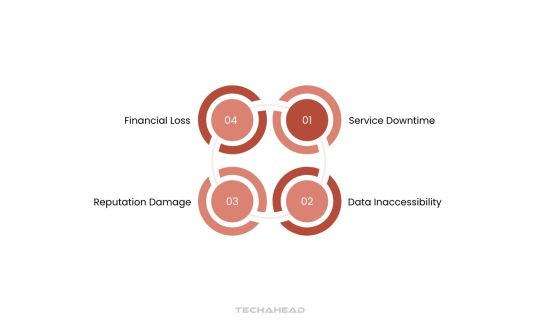
Cloud outages are periods when cloud-hosted applications and services become temporarily inaccessible. During these downtimes, users face slow response times, connectivity issues, or complete service disruptions. These interruptions can severely impact businesses across multiple dimensions.
The financial repercussions of cloud outages are immediate and far-reaching. When services go offline, organizations lose revenue as customers are unable to complete transactions. Additionally, businesses cannot track critical performance metrics, which can lead to operational inefficiencies and delayed decision-making.
Beyond monetary losses, cloud outages also cause reputational damage. Frustrated customers often perceive these disruptions as a sign of unreliability. A lack of transparent communication during downtime further exacerbates customer dissatisfaction. Over time, this can erode trust and push clients toward competitors offering more dependable solutions.
Another critical concern during cloud outages is the potential for legal consequences. If an outage leads to data loss, breaches, or compromised privacy, businesses may face litigation, regulatory penalties, and increased scrutiny. The fallout from such incidents can add both financial and reputational burdens.
Long-term consequences of cloud outages include reduced customer satisfaction, loss of client loyalty, and ongoing revenue declines. Organizations may also incur significant costs to restore affected systems and prevent future outages. Inadequate cloud infrastructure increases the risk of repeated disruptions, making businesses more vulnerable to prolonged downtimes.
To mitigate these risks, organizations must proactively invest in robust backup and recovery systems. Reliable disaster recovery plans and redundancies help minimize downtime, ensuring business continuity during unforeseen cloud outages. This strategic approach safeguards revenue streams, protects customer trust, and fortifies operational resilience.
Common Causes of Cloud Outages
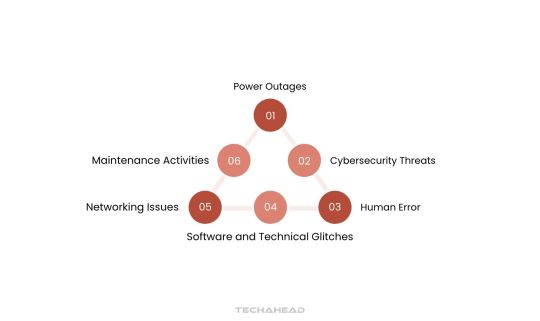
Cloud outages can stem from various factors, both within and beyond the control of cloud vendors. These challenges must be addressed to ensure cloud services meet Service Level Agreements (SLAs) with optimal performance and reliability.
Power Outages
Power disruptions are one of the most prevalent causes of cloud outages. Data centers operate on an enormous scale, consuming anywhere from tens to hundreds of megawatts of electricity. These facilities often rely on national power grids or third-party-operated power plants.
Consistently maintaining sufficient electricity supply becomes increasingly difficult as demand surges alongside market growth. Limited power scalability can leave cloud infrastructure vulnerable to sudden disruptions, impacting the availability of hosted services. To address this, cloud vendors invest heavily in backup solutions like on-site generators and alternative energy sources.
Cybersecurity Threats
Cyber attacks, such as Distributed Denial of Service (DDoS) attacks, overwhelm data centers with malicious traffic, disrupting legitimate access to cloud services. Despite robust security measures, attackers continuously identify loopholes to exploit. These intrusions may trigger automated protective mechanisms that mistakenly block legitimate users, leading to unexpected downtime.
In severe cases, breaches result in data leaks, service shutdowns, or prolonged outages. Cloud vendors constantly refine their defense systems to combat these evolving threats and ensure service continuity despite rising cybersecurity challenges.
Human Error
Human errors, though rare, can have catastrophic effects on cloud infrastructure. A single misconfiguration or incorrect command may trigger a chain reaction, causing widespread outages. Even leading cloud providers have experienced significant disruptions due to human oversight.
For instance, a human error at an AWS data center in 2017 led to widespread Internet outages globally. Although anomaly detection systems can identify such issues early, complete restoration often requires system-wide restarts, prolonging the recovery period. Cloud vendors mitigate this risk through rigorous protocols, automation tools, and comprehensive staff training.
Software and Technical Glitches
Cloud infrastructure relies on a complex interplay of hardware and software components. Even minor bugs or glitches within this ecosystem can trigger unexpected cloud outages. Technical faults may remain undetected during routine monitoring until they manifest as critical service disruptions. When these incidents occur, identifying and resolving the root cause can take time, leaving end-users unable to access essential services. Cloud vendors implement automated monitoring, rigorous testing, and proactive maintenance to identify vulnerabilities before they impact operations.
Networking Issues
Networking failures are other significant contributor to cloud outages. Cloud vendors often rely on telecommunications providers and government-operated networks for global connectivity. Issues in these external networks, such as damaged infrastructure or cross-border disruptions, are beyond the vendor’s direct control. To mitigate these risks, leading cloud providers operate data centers across geographically diverse regions. Dynamic workload balancing allows cloud vendors to shift operations to unaffected regions, ensuring uninterrupted service delivery even during network failures.
Maintenance Activities
Scheduled and unscheduled maintenance is essential for improving cloud infrastructure performance and cloud security. Cloud vendors routinely conduct upgrades, fixes, and system optimizations to enhance service delivery. However, these maintenance activities may require temporary service interruptions, workload transfers, or full system restarts.
During this period, end-users may experience service disruptions classified as cloud outages. Vendors strive to minimize downtime through well-planned maintenance windows, redundancy systems, and real-time communication with customers.
Global Cloud Outage Statistics and Notable Cases
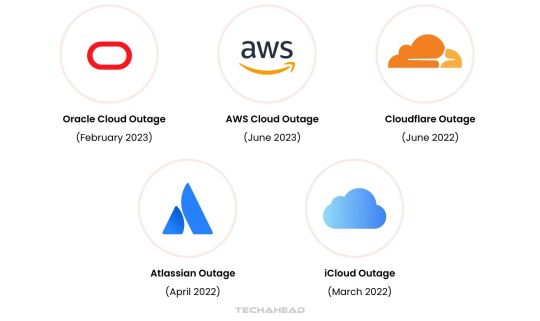
Cloud outages remain a critical challenge for organizations worldwide, often disrupting essential operations. Below are significant real-world examples and insights drawn from these incidents to uncover key lessons.
Oracle Cloud Outage (February 2023)
In February 2023, Oracle Cloud Infrastructure encountered a severe outage triggered by an erroneous DNS configuration update. This impacted Oracle’s Ashburn data center, causing widespread service interruptions. The outage affected Oracle’s internal systems and global customers, highlighting the importance of robust change management protocols in cloud operations.
AWS Cloud Outage (June 2023)
AWS faced an extensive service disruption in June 2023, affecting prominent services, including the New York Metropolitan Transportation Authority and the Boston Globe. The root cause was a subsystem failure managing AWS Lambda’s capacity, revealing the need for stronger subsystem reliability in serverless environments.
Cloudflare Outage (June 2022)
A network configuration change caused an unplanned outage at Cloudflare in June 2022. The incident lasted 90 minutes and disrupted major platforms like Discord, Shopify, and Peloton. This outage underscores the necessity for rigorous testing of configuration updates, especially in global networks.
Atlassian Outage (April 2022)
Atlassian suffered one of its most prolonged outages in April 2022, lasting up to two weeks for some users. The disruption was due to underlying cloud infrastructure problems compounded by ineffective communication. This case emphasizes the importance of clear communication strategies during extended outages.
iCloud Outage (March 2022)
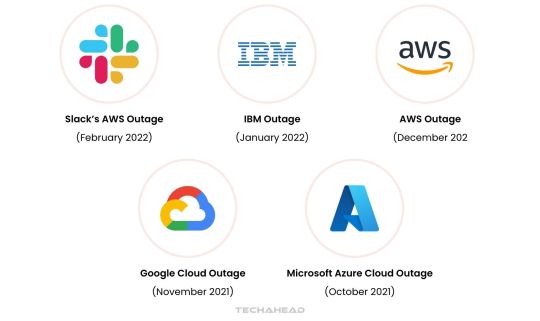
Slack’s AWS Outage (February 2022)
In February 2022, Slack users faced a five-hour disruption due to a configuration error in its AWS cloud infrastructure. Over 11,000 users experienced issues like message failures and file upload problems. The outage highlights the need for quick troubleshooting processes to minimize downtime.
IBM Outage (January 2022)
IBM encountered two significant outages in January 2022, the first lasting five hours in the Dallas region. A second, one-hour outage impacted virtual private cloud services globally due to a remediation misstep. These incidents highlight the importance of precision during issue resolution.
AWS Outage (December 2021)
AWS’s December 2021 outage disrupted key services, including API Gateway and EC2 instances, for nearly 11 hours. The issue stemmed from an automated error in the “us-east-1” region, causing network congestion akin to a DDoS attack. This underscores the necessity for robust automated system safeguards.
Google Cloud Outage (November 2021)
A two-hour outage impacted Google Cloud in November 2021, disrupting platforms like Spotify, Etsy, and Snapchat. The root cause was a load-balancing network configuration issue. This incident highlights the role of advanced network architecture in maintaining service availability.
Microsoft Azure Cloud Outage (October 2021)
Microsoft Azure experienced a six-hour service disruption in October 2021 due to a software issue during a VM architecture migration. Users faced difficulties deploying virtual machines and managing basic services. This case stresses the need for meticulous oversight during major architectural changes.
These examples serve as critical reminders of vulnerabilities in cloud systems. Businesses can minimize the impact of cloud outages through proactive measures like redundancy, real-time monitoring, and advanced disaster recovery planning.
Ways to Manage Cloud Outages
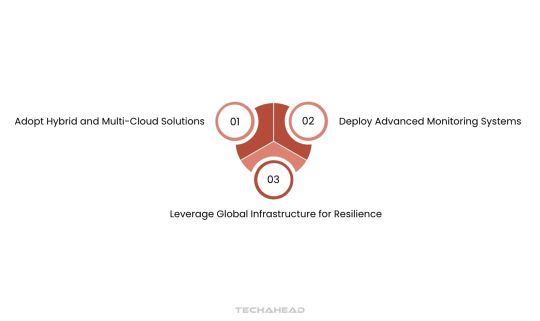
While natural disasters are unavoidable, strategic measures can help you mitigate and overcome cloud outages effectively.
Adopt Hybrid and Multi-Cloud Solutions
Redundancy is key to minimizing cloud outages. Relying on a single provider introduces a single point of failure, which can disrupt your operations. Implementing failover mechanisms ensures continuous service delivery during an outage.
Hybrid cloud solutions combine private and public cloud infrastructure. Critical workloads remain operational on the private cloud even when the public cloud fails. This approach not only safeguards core business functions but also ensures compliance with data regulations.
According to Cisco’s 2022 survey of 2,577 IT decision-makers, 73% of respondents utilized hybrid cloud for backup and disaster recovery. This demonstrates its effectiveness in reducing downtime risks.
Multi-cloud solutions utilize multiple public cloud providers simultaneously. By distributing workloads across diverse cloud platforms, businesses eliminate single points of failure. If one service provider experiences downtime, another provider ensures service continuity.
Deploy Advanced Monitoring Systems
Cloud outages do not always cause full system failures. They can manifest as delayed responses, missed queries, or slower performance. Such anomalies, if ignored, can impact user experience before they escalate into major outages.
Implementing cloud monitoring systems helps you proactively detect irregularities in performance. These tools identify early warning signs, allowing you to resolve potential disruptions before they affect end users. Real-time monitoring ensures seamless operations and reduces the risk of unplanned outages.
Leverage Global Infrastructure for Resilience
Natural disasters and regional disruptions are inevitable, but you can minimize their impact. Distributing IT infrastructure across multiple geographical locations provides a robust solution against localized cloud outages.
Instead of relying on a single data center, consider global redundancy strategies. Deploy backup systems in geographically diverse regions, such as U.S. Central, U.S. West, or European data centers. This ensures uninterrupted service delivery, even if one location goes offline.
For businesses operating in Europe, adopting multi-region solutions also supports GDPR compliance. This way, customer data remains protected, and operations continue seamlessly, regardless of cloud disruptions.
By leveraging global infrastructure, businesses can enhance reliability, improve redundancy, and build resilience against unforeseen cloud outages.
Additional Preventive Measures for Businesses
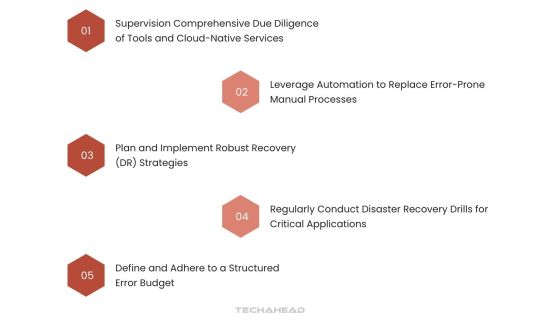
To effectively mitigate the risk of cloud outages, CIOs can adopt a multi-faceted approach that enhances resilience and ensures business continuity:
Supervision Comprehensive Due Diligence of Tools and Cloud-Native Services
Conduct a thorough evaluation of cloud-native services, ensuring they meet organizational requirements for scalability, security, and performance. This involves reviewing vendor capabilities, compatibility with existing infrastructure, and potential vulnerabilities that could lead to cloud outages. Regular audits help identify gaps early, preventing disruptions.
Leverage Automation to Replace Error-Prone Manual Processes
Automating operational tasks, such as provisioning, monitoring, and patch management, minimizes the human errors often linked to cloud outages. Automation tools also enhance efficiency by streamlining workflows, allowing IT teams to focus on proactive system improvements rather than reactive troubleshooting.
Plan and Implement Robust Recovery (DR) Strategies
A well-structured DR strategy is critical to quickly recover from cloud outages. This involves identifying mission-critical applications, determining acceptable recovery time objectives (RTOs), and creating recovery workflows. Comprehensive planning ensures minimal data loss and rapid resumption of services, even during large-scale disruptions.
Regularly Conduct Disaster Recovery Drills for Critical Applications
Testing DR plans through realistic drills allows organizations to simulate cloud outages and measure the effectiveness of their recovery protocols. These exercises reveal weaknesses in existing plans, providing actionable insights for improvement. Frequent testing also builds confidence in the system’s ability to handle unexpected disruptions.
Define and Adhere to a Structured Error Budget
An error budget establishes a clear threshold for acceptable service disruptions, balancing innovation and stability. It quantifies the permissible level of failure, enabling organizations to implement risk management frameworks effectively. This approach ensures proactive maintenance, minimizing the chances of severe cloud outages while allowing room for improvement.
By combining these preventive measures with ongoing monitoring and optimization, CIOs can significantly reduce the likelihood and impact of cloud outages, safeguarding critical operations and maintaining customer trust.
Conclusion
Although cloud outages are unavoidable when depending on cloud services, understanding their causes and consequences is crucial. Organizations can mitigate the risks of cloud outages by proactively adopting best practices that ensure operational resilience.
Key strategies include implementing redundancy to eliminate single points of failure, enabling continuous monitoring to detect issues early, and scheduling regular backups to safeguard critical data. Robust security measures are also essential to protect against vulnerabilities that could exacerbate outages.
In today’s cloud-reliant environment, being proactive is vital. Businesses that anticipate potential disruptions are better positioned to maintain seamless operations and customer trust. Proactive planning not only minimizes the operational impact of cloud outages but also reinforces long-term business continuity.
For better seamless cloud computing you should go for a proud partner like TechAhead. We can help you in migrating and consulting for your cloud environment.
Source URL: https://www.techaheadcorp.com/blog/understanding-cloud-outages-causes-consequences-and-mitigation-strategies/
0 notes
Text
How to Choose the Right Cloud Service Provider for Your Business
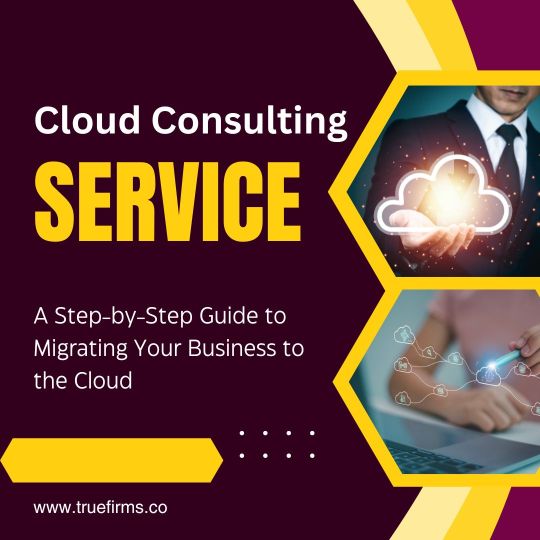
Selecting the right cloud service provider is one of the most critical decisions in your migration journey. This blog highlights the key factors to consider when evaluating providers like AWS, Microsoft Azure, and Google Cloud. Learn how pricing structures, features, scalability options, and security measures differ between providers. We also discuss compliance standards, SLAs, and customer support, helping you make an informed decision. A reliable cloud provider can ensure your migration is smooth, secure, and aligned with your long-term goals. Whether you’re new to cloud computing or looking to switch providers, this guide will simplify your decision-making process.
Read more:
A Step-by-Step Guide to Migrating Your Business to the Cloud
#cloud computing#cloud services#cloud security#cloudcloud infrastructure#cloud infrastructure#cloud infrastrasture#cloud migration
0 notes
Text
How Technology is Transforming Business Communication and Management
In this world of business, technology has become the single most pivotal force in shaping organizations to communicate, manage operations, and interact with their clients.
The rapid advancements in communication tools, automation in processes, and management systems have let businesses achieve more efficiency, competitiveness, and agility toward market dynamics. This transformation has not only aligned the internal processes but has also revolutionized customer engagement, team collaboration, and decision-making.
The article now goes through how technology is changing business communication and management, highlighting key trends and tools that drive such change.
Cloud-Based Communication Platforms
Among the many innovations in business communication, cloud technology is likely the most impactful. Traditional phone systems and on-premise email servers are giving way to flexible, scalable, and more economical cloud platforms.
Unified Communication as a Service (UCaaS)
The latest of these is Unified Communication as a Service (UCaaS). With UCaaS, voice, video, messaging, and conferencing are all integrated into one solution accessible from any device capable of accessing the internet. In other words, work teams can communicate in real-time is the technology that has made working from home and hybrid workplaces possible, as companies remain productive and their workers communicate effectively over-dispersed geographies.
Reduced Infrastructure Cost
With the use of cloud-supported communication tools, a company isn't required to invest in hardware and other maintenance costs of conventional systems.
Instead of investing in a PBX system or an on-premise data center, companies can invest in subscription models that scale as required. This has made access to enterprise-level communication tools easier for small and medium businesses without heavy upfront investments.
Improved Security and Data Privacy
Cloud communication platforms are also integrated with strong security functions, including encryption, multi-factor authentication, and adherence to data privacy laws. This means that sensitive business communication will be safe from unauthorized access and prevent the leakage of critical business information.
Mobile Technology for Remote Management
Mobile technology has made it possible for business leaders and employees to stay connected and manage tasks from anywhere, at any time. A prime example of this transformation is the role of mobile connectivity in facilitating seamless communication during business trips. With tools like mobile project management apps and communication platforms, remote work has become more seamless.
For esim international travel, professionals can easily switch between networks without the hassle of changing SIM cards, ensuring they remain connected wherever they go. This ensures that even when traveling internationally, business leaders can access important documents, attend virtual meetings, and stay in touch with their teams without interruptions.
AI in Communication
The use of AI is redefining business-customer interaction and internal communication in organizations.
● AI-Powered Customer Support: AI-powered chatbots and virtual assistants have indeed completely transformed customer support. Such applications can process hundreds of queries simultaneously in real-time and promptly respond with accuracy to the customers 24/7.
● Natural Language Processing (NLP): This is a branch of AI-engaging computers to perceive and interpret human language. Companies are leveraging NLP in email, chat, and customer feedback analyses to understand major trends and problems in communication.
● AI in Internal Communication: Coupled with communication with customers, AI also enhances the internal processes of communication. AI-driven tools could automate routine tasks of meeting scheduling, reminders, and keeping the workflow organized.
Team Management Collaboration Tools
Collaboration tools have now played a very important part in team management, with many employees embracing the concept of working from home and hybrid work models.
Project Management Software
Project management tools allow your team to organize work, follow through on progress, and collaborate in real-time. On the platform, members can delegate tasks, set deadlines, and communicate effectively so there is no miscommunication or a lost deadline.
They even give insights into the timeline of projects to ensure people are on the same page about what is happening with the status of a project.
Real-Time Collaboration on Documents
This has been further improved through other platforms, whereby many users can edit one document simultaneously. A team can edit a document spreadsheet or presentation, comment, and even suggestions that can be reviewed. This certainly has taken collaboration to a new level, more so when the team members are scattered in different locations.
Virtual Meeting Tools
Built-in integrations like screen sharing, virtual whiteboards, and breakout rooms make remote meetings truly far more interactive. The hybrid way of working has made these platforms do magic, connecting all the employees, those in-office and working remotely, to one platform where every single one of them has equal opportunity to participate and contribute.
Automation in Business Management
Automation is another crucial technology transforming how business activities are managed in any business to reduce workloads and further enhance operational efficiency.
● Workflow Automation: This helps businesses automate repetitive activities. It could also mean that customer data is routed automatically to a CRM system, instead of having to be keyed in when a new lead is created or a customer makes a purchase, reducing chances of human error and thus assuring speedier processing.
● Automated Reporting and Analytics: Automation tools will immediately report, at a frequency defined by the business rules, to make sure that managers and leaders have access to current information for making informed decisions.
● Human Resources and Payroll Automation: Automation has also brought a sea change in HR and payroll practices. This ensures further compliance with labor laws and frees up administrative burdens on HR teams to focus on employee engagement and development.
Improved Customer Relationship Management
The application of CRM in business is central to the handling of interactions with clients and prospects. Advanced modern CRM systems, leveraging AI and automation, may unlock deeper insights for businesses into customer behavior and preferences for personalized communication and marketing strategies.
AI-Driven CRMs
CRM systems apply AI toward identifying patterns in how customers interact and then predict their future behaviors. This can include automation of things like lead scoring on the likelihood to convert, suggesting next steps for sales teams, and personalized marketing content to better engage prospects.
AI-driven CRMs offer improvements in business-customer relations because they ensure that the communication is timely, relevant, and personal.
Omnichannel Communication
The modern CRM system unifies multi-channel communications like email, social media, phone, and chat - all within one system. This ability to engage the customer across the touchpoints allows for a consistent and seamless experience in engaging them.
When the customer calls the business, writes an email, or reaches out via social media, the CRM system monitors all of these interactions to enable insight into the big picture of the customer's journey.
Data Analytics and Business Intelligence (BI)
It has indeed brought about an absolute revolution in the way businesses make decisions-from insights into performance, customer behavior, and market trends.
Real-Time Data Insights
This allows the organization to realize the data in real-time to make informed strategic decisions. These tools aggregate data from various sources into comprehensible dashboards. Based on the observation of KPIs, business executives make fact-based decisions instead of gut-based decisions.
Predictive Analytics
Artificial Intelligence and machine learning-driven predictive analytics can help businesses to accurately predict future trends and outcomes.
For example, companies can estimate the rate of churn in customers, optimize inventory levels, and even predict market demand using historical data. Using this technology, predictive analytics enables a business to pre-emptively make decisions that will enhance efficiency and profitability.
Conclusion
Technology is transforming business communication and management on an unprecedented scale. Business managers leverage these innovations on everything from cloud-based communication platforms and AI-powered customer support to automation tools and data analytics.
As technology continues to evolve, only companies that adopt new tools will remain flexible in changing market conditions, enhance customer experience, and ensure long-term success. This is what will allow businesses to continue to be competitive and thrive in the high-speed world of business today.
FAQs
1.At which points does the utilization of cloud-based communication tools improve the way business is conducted?
Cloud-based tools make communication easier, the cost of the infrastructure is reduced, and it allows for working remotely.
2.What part does AI play in improving customer service?
AI empowers businesses by providing constant support through chatbots and virtual assistants, enhancing response time and customer satisfaction.
3.Why is automation important for business management?
Automation reduces human effort to the lowest level, reduces errors, and speeds up operations in many business processes.
Daniel Martin
Dan has had hands-on experience in digital marketing since 2007. He has been building teams and coaching others to foster innovation and solve real-time problems. In his previous work experiences, he has developed expertise in digital marketing, e-commerce, and social media. When he's not working, Dan enjoys photography and traveling.
LinkedIn Profile
Share in the comments below: Questions go here
#technology#business#communications#management#customer engagement#team collaboration#decision making#management systems#cloud technology#infrastructure cost#data privacy#security#remote management#virtual meeting tools#workflow automation#analytics
0 notes
Text
A Strategic Approach to Cloud Migration: How Web Synergies Ensures a Seamless Transition
In today’s fast-paced digital landscape, businesses are increasingly recognising the need for a well-planned cloud migration strategy. Moving operations to the cloud isn’t just about upgrading technology—it’s a critical step towards improving efficiency, scalability, and resilience. However, without expert guidance, this transition can present unforeseen challenges. At Web Synergies, we’ve fine-tuned our approach to ensure that cloud migration is a smooth, secure, and beneficial process for businesses of all sizes.
Why Cloud Migration Matters
As industries embrace digital transformation, cloud adoption has become essential for organisations to remain competitive. A successful cloud migration enables:
Increased Operational Efficiency: Cloud solutions allow businesses to streamline operations, reduce downtime, and eliminate costly on-premises hardware.
Enhanced Data Security: Today’s cloud platforms come with advanced security measures to protect sensitive data and ensure compliance with industry standards.
Scalability and Flexibility: With cloud infrastructure, businesses can effortlessly scale resources to meet changing demands and support growth.
However, the journey to the cloud requires careful planning and a tailored approach. That’s where Web Synergies stands out.
Web Synergies’ Proven Cloud Migration Strategy
Our team at Web Synergies understands that every business has unique requirements and goals. By focusing on a strategy-driven migration process, we ensure that each step aligns with your specific business objectives. Here’s how we do it:
Assessment and Planning The foundation of a successful migration is a thorough assessment. We begin by evaluating your existing infrastructure, identifying critical applications, and pinpointing potential challenges. Our team creates a migration roadmap that prioritises business continuity and minimises disruption.
Customised Migration Pathway Whether you’re moving to a public, private, or hybrid cloud, Web Synergies tailors the migration pathway to best suit your organisational needs. Our customised approach ensures that your business enjoys the full benefits of the cloud without unnecessary complications.
Data Security and Compliance In today’s digital age, data security is paramount. Web Synergies employs the latest security protocols, ensuring your data remains safe throughout the migration. Our compliance-focused solutions meet industry standards, offering peace of mind that your information is protected.
Optimising and Testing A seamless transition means thorough testing. Before the full migration, we conduct rigorous testing to identify and resolve any issues. This ensures a stable and optimised cloud environment tailored to your specific needs.
Post-Migration Support Our commitment doesn’t end once the migration is complete. We provide ongoing support to help you navigate your new cloud environment, optimise costs, and leverage advanced cloud features for enhanced productivity.
Benefits of Choosing Web Synergies for Cloud Migration
Partnering with Web Synergies means more than just moving to the cloud. It’s about setting your business up for success in a digital-first world. Here’s what sets us apart:
Proven Expertise: Our seasoned team has a wealth of experience across various industries, ensuring a smooth migration that fits your needs.
Future-Ready Solutions: We design scalable cloud solutions that not only support your current requirements but are flexible enough to adapt to future demands.
Enhanced Agility: With our cloud migration services, your business gains the agility to respond quickly to market changes, fostering innovation and growth.
Embrace the Cloud with Confidence
Migrating to the cloud is a significant step in your business’s digital journey. With Web Synergies’ strategic approach, you can make this transition confidently, knowing you have a partner committed to your success. From assessment and planning to post-migration support, we’re here to ensure that your journey to the cloud is seamless and secure.
Ready to take your business to new heights with cloud migration? Partner with Web Synergies today to experience a smooth, strategic, and secure move to the cloud.
#Cloud migration strategy#Seamless cloud migration#Cloud solutions for businesses#Data security in cloud migration#Post-migration support#Web Synergies cloud services#Cloud infrastructure optimisation#Business continuity in cloud migration#Future-ready cloud solutions#Secure cloud transition
0 notes
Text
Reliable IT Infrastructure Solutions for Businesses
Vivency Technology LLC specializes in providing cutting-edge IT infrastructure solutions tailored to meet the diverse needs of businesses and organizations. Our services ensure seamless operations, enhanced security, and optimal performance for your IT environment.
We offer a comprehensive range of IT infrastructure services, including: ✅ Network Solutions – Reliable and scalable networking for seamless connectivity. ✅ Data Center Solutions – Advanced data storage, management, and security solutions. ✅ Cybersecurity Solutions – Protect your business with robust security measures. ✅ IT Consulting & Managed Services – Expert guidance and support for IT optimization.
Enhance your IT infrastructure with Vivency Technology LLC. Contact us today for customized solutions!
#IT infrastructure solutions#network solutions#data center solutions#cybersecurity solutions#IT consulting services#managed IT services#business IT solutions#IT infrastructure management#IT support services#enterprise IT solutions#secure IT infrastructure#cloud infrastructure solutions#network security solutions#IT infrastructure company#IT infrastructure provider#scalable IT solutions#technology infrastructure services#IT system integration#IT infrastructure optimization#Vivency Technology LLC.
0 notes